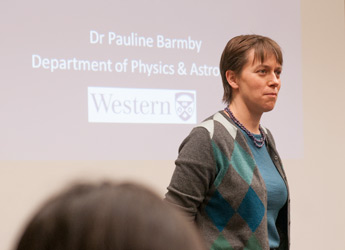
Media
Reach for the Stars: Citizen Science & Astronomy
MakerCulture - Science Group Jess, Maria and Carrie talked to associate professor Pauline Barmby at the University of Western Ontario. She gave us some insight on who is using Galaxy Zoo and why. Here's a teaser from that interview.
Lightning Talks 2
Alex Hagen, Peter Teuben, Christine Koepferl, Neil Crighton, Mathieu Servillat, Rebecca Smethurst , Eric Jeschke, Wolfgang Kerzendorf, Pauline Barmby Second round of lightning talks at the Python in Astronomy workshop 2015. http://python-in-astronomy.github.io
Bucke prize lecture 1080p24
At Western University, Canada, The Florence Bucke Science Prize For 2014 was awarded to Dr. Pauline Barmby of the Department of Physics and Astronomy. Dr. Barmby's public lecture was titled "The Beautiful Science of Nearby Galaxies. Giving a history of the Florence Bucke Prize is Dean of Science, Dr. Charmain Dean. Introducing the speaker is the Chair of the Department of Physics and Astronomy, Dr. Shantanu Basu. This public lecture was given on Tuesday, April 22, 2014.
The Infrared Array Camera (IRAC) for the Spitzer Space Telescope
Published by The Astrophysical Journal Supplement Series
2004 The Infrared Array Camera (IRAC) is one of three focal plane instruments on the Spitzer Space Telescope. IRAC is a four-channel camera that obtains simultaneous broadband images at 3.6, 4.5, 5.8, and 8.0 μm. Two nearly adjacent 5.2'× 5.2' fields of view in the focal plane are viewed by the four channels in pairs (3.6 and 5.8 μm; 4.5 and 8 μm)...
URL: http://iopscience.iop.org/article/10.1086/422843/fulltext/
Star formation in AEGIS field galaxies since z= 1.1: The dominance of gradually declining star formation, and the main sequence of star-forming galaxies
Published by The Astrophysical Journal Letters
2007 We analyze star formation (SF) as a function of stellar mass (M*) and redshift z in the All-Wavelength Extended Groth Strip International Survey. For 2905 field galaxies, complete to 1e10 (1e10.8) M☉ at z< 0.7 (1), with Keck spectroscopic redshifts out to z= 1.1, we compile SF rates (SFRs) from emission lines, GALEX, and Spitzer MIPS 24 μm photometry, optical-NIR M* measurements, and HST morphologies...
Galactic Cepheids with Spitzer. II. Search for Extended Infrared Emission
Published by The Astronomical Journal
2011 A deep and detailed examination of 29 classical Cepheids with the Spitzer Space Telescope has revealed three stars with strong nearby extended emission detected in multiple bands which appears to be physically associated with the stars. RS Pup was already known to possess extended infrared emission, while the extended emission around the other two stars (S Mus and δ Cep) is newly discovered in our observations. Four other stars (GH Lup, ℓ Car, T Mon, and X Cyg) show tentative evidence for extended infrared emission..
URL: http://iopscience.iop.org/article/10.1088/0004-6256/141/2/42/meta
Dusty Waves on a Starry Sea: The Mid-Infrared View of M31
Published by The Astrophysical Journal Letters
2006 Mid-infrared observations of the Andromeda galaxy, M31, obtained with the Infrared Array Camera on board the Spitzer Space Telescope are presented. The image mosaics cover areas of approximately 3.7deg × 1.6deg and include the satellite galaxies M32 and NGC 205. The appearance of M31 varies dramatically in the different mid-infrared bands, from the smooth bulge and disk of the old stellar population seen at 3.6 μm to the well-known "10 kpc ring" dominating the 8 μm image..
URL: http://iopscience.iop.org/article/10.1086/508626/fulltext/
Biography
Pauline Barmby degrees from the University of British Columbia and Harvard University. Her PhD thesis on the star clusters belonging to the Andromeda galaxy, involved many trips to telescopes and much more snow than most people associate with Arizona. After receiving my PhD, she worked at the Harvard-Smithsonian Center for Astrophysics as part of the team responsible for building and testing the IRAC camera on the Spitzer Space Telescope. In 2007, she joined Western's Department of Physics and Astronomy. In 2015-18, she joined the academic leadership in the Faculty of Science as associate dean (graduate and postdoctoral studies) and acting dean. Barmby's astronomy research is in the use of computer data-mining techniques and community-developed software to facilitate knowledge extraction from astronomical data. She's interested in communicating science to the public and teaching computational techniques to scientists.
Recognition/Reconnaissance
Outreach Award
Western Faculty of Science, 2010
Florence Bucke Prize
Western Faculty of Science, 2014
Group Achievement Award
Awarded to Spitzer Space Telescope Payload Team, NASA, 2004
Additional Titles and Affiliations
Software / Data Carpentry Code of Conduct Committee : Chair
International Astronomical Union : Member
International Astrostatistics Association Membership Committee : Member
Dunlap Institute : Review Committee
COSPAR : Member
Canadian Astronomical Society : Member
Canadian Astronomical Society Equity & Inclusivity Committee: Member
American Astronomical Society : Member
Past Talks
The Story of Space Telescopes
David Dunlap Observatory Star Talks
Toronto, ON, August 29, 2015
The M31 nucleus in the mid-infrared
American Astronomical Society
Seattle, WA, January 5, 2015
Stellar populations in the outskirts of M31: the mid infrared view
IAU Symposium 321, Foundation and Evolution of Galaxy Outskirts
Toledo, Spain, March 14, 2016
Pieces of Andromeda: machine-learning and big data techniques applied to M31
Canadian Astronomical Association Meeting
Winnipeg, MN., June 1, 2016
Astroinformatics: the Big Data of the Universe
Royal Astronomical Society of Canada, London Centre
London, ON, November 18, 2016
Research Grants
Star Formation Histories of Nearby Galaxies
Organization: NSERC Discovery GrantGrant amount: 125k
Details:
2008 - 2013
Star Formation Histories of Nearby Galaxies
Organization: Ontario Early Researcher AwardGrant amount: 140k
Details:
2008 - 2013
Far out: Tracing the mass in M31
Organization: Spitzer Science CenterGrant amount: 16k
Details:
2012
Assembling the big picture in nearby galaxies
Organization: NSERC Discovery GrantGrant amount: 135k
Details:
2013 - 2018
Astroinformatics
Organization: Western University ADFGrant amount: 84k
Details:
2012 - 2014


